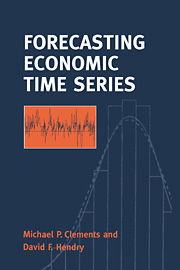Book contents
- Frontmatter
- Contents
- List of figures
- List of tables
- Preface
- Common acronyms
- 1 An introduction to forecasting
- 2 First principles
- 3 Evaluating forecast accuracy
- 4 Forecasting in univariate processes
- 5 Monte Carlo techniques
- 6 Forecasting in cointegrated systems
- 7 Forecasting with large-scale macroeconometric models
- 8 A theory of intercept corrections: beyond mechanistic forecasts
- 9 Forecasting using leading indicators
- 10 Combining forecasts
- 11 Multi-step estimation
- 12 Parsimony
- 13 Testing forecast accuracy
- 14 Postscript
- Glossary
- References
- Author index
- Subject index
8 - A theory of intercept corrections: beyond mechanistic forecasts
Published online by Cambridge University Press: 02 November 2009
- Frontmatter
- Contents
- List of figures
- List of tables
- Preface
- Common acronyms
- 1 An introduction to forecasting
- 2 First principles
- 3 Evaluating forecast accuracy
- 4 Forecasting in univariate processes
- 5 Monte Carlo techniques
- 6 Forecasting in cointegrated systems
- 7 Forecasting with large-scale macroeconometric models
- 8 A theory of intercept corrections: beyond mechanistic forecasts
- 9 Forecasting using leading indicators
- 10 Combining forecasts
- 11 Multi-step estimation
- 12 Parsimony
- 13 Testing forecast accuracy
- 14 Postscript
- Glossary
- References
- Author index
- Subject index
Summary
We outline a general framework for analysing the adjustments typically made to model-based forecasts. Published forecasts based on large-scale macroeconometric models reflect to varying degrees the properties of the models and the adjustments made by their proprietors in arriving at a final forecast. The scope for, and importance of, such adjustments has long been recognized, and recent work by the ESRC Macroeconomic Modelling Bureau suggests that the adjustments made by the main UK forecasting groups to their model-based forecasts usually result in improved forecast accuracy. Our theory of intercept corrections is based on the relationships between the data generating process, the estimated econometric model, the mechanics of the forecasting technique, the data accuracy and any information about future events held at the beginning of the forecast period. It indicates a variety of situations under which intercept corrections will enhance forecast accuracy. The resulting forms of intercept correction differ, and in any practical setting would have to be combined, although we do not explicitly consider interactions between them. Intercept corrections are shown to offer some protection against structural breaks, and as such are an important aspect of a general approach to the theory of economic forecasting which explicitly recognizes that the model is not the mechanism, and that the mechanism is subject to change.
- Type
- Chapter
- Information
- Forecasting Economic Time Series , pp. 180 - 206Publisher: Cambridge University PressPrint publication year: 1998

